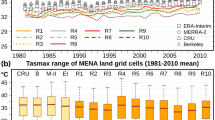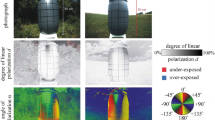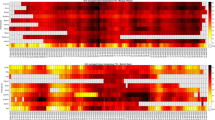Abstract
Survival in hot deserts has always posed a problem for man; Moses had to solve it in order to lead the children of Israel through the wilderness of the Sinai—a formidable hot desert. It seems likely that the present inhabitants of the Sinai, the Bedouins, would have optimised their solutions for desert survival during their long tenure in this desert Yet, one may have doubts on first encountering Bedouins wearing black robes and herding black goats. We have therefore investigated whether black robes help the Bedouins to minimise solar heat loads in a hot desert. This seemed possible because experiments have shown that white hair on cattle1,2 and white feathers on pigeons3 permit greater penetration of short-wave radiation to the skin than black. In fact, more heat flowed inward through white pigeon plumage than through black when both were exposed to simulated solar radiation at wind speeds greater than 3 m s−1 (ref. 3). We report here that the amount of heat gained by a Bedouin exposed to the hot desert is the same whether he wears a black or a white robe. The additional heat absorbed by the black robe was lost before it reached the skin.
This is a preview of subscription content, access via your institution
Access options
Subscribe to this journal
Receive 51 print issues and online access
$199.00 per year
only $3.90 per issue
Buy this article
- Purchase on SpringerLink
- Instant access to full article PDF
Prices may be subject to local taxes which are calculated during checkout
Similar content being viewed by others

References
Hutchinson, J. C. D. & Brown, C. D. J. appl. Physiol. 26, 454–464 (1969).
Cena, K. & Monteith, J. L. Proc. R. Soc. 199, 377–393 (1975).
Walsberg, G. E., Campbell, G. S. & King, J. R. J. comp. Physiol. 126, 211–212 (1978).
Finch, V. A. J. thermal Biol. 1, 143–148 (1976).
Finch, V. A., Dmi'el, R., Boxman, R., Shkolnik, A. & Taylor, C. R. Physiol. Zool. (in the press).
Swinbank, W. C. Q. JI R. met. Soc. 89, 339–348 (1963).
Dubois, D. & Dubois, E. F. Arch. intern Med. 15, 868–881 (1915).
Belding, H. S., Russell, H. D., Darling, R. C. & Folk, G. E. J. Physiol. 149, 223–239 (1947).
Breckenridge, J. R., Pratt, R. L. & Woodcock, A. H. Fedn Prod. 19, 178 (1960).
Author information
Authors and Affiliations
Rights and permissions
About this article
Cite this article
Shkolnik, A., Taylor, C., Finch, V. et al. Why do Bedouins wear black robes in hot deserts?. Nature 283, 373–375 (1980). https://doi.org/10.1038/283373a0
Received:
Accepted:
Issue Date:
DOI: https://doi.org/10.1038/283373a0
This article is cited by
-
A century of exercise physiology: concepts that ignited the study of human thermoregulation. Part 4: evolution, thermal adaptation and unsupported theories of thermoregulation
European Journal of Applied Physiology (2024)
-
A century of exercise physiology: concepts that ignited the study of human thermoregulation. Part 3: Heat and cold tolerance during exercise
European Journal of Applied Physiology (2024)
-
Climate change and health in Israel: adaptation policies for extreme weather events
Israel Journal of Health Policy Research (2013)
-
The evolution of sweat glands
International Journal of Biometeorology (1991)
-
Is a black coat in the desert a means of saving metabolic energy?
Nature (1980)


